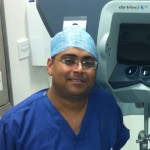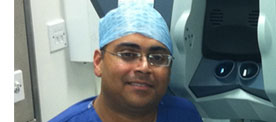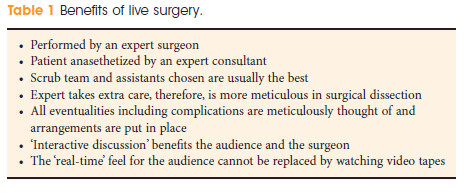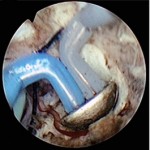A benedictory ode to urological live surgery
This blog  was originally published as a comment article in BJU International, 112: 11–12. doi: 10.1111/j.1464-410X.2012.11780.x
was originally published as a comment article in BJU International, 112: 11–12. doi: 10.1111/j.1464-410X.2012.11780.x
With the explosion and expansion of information technology, instantaneous dissemination of medical knowledge across the globe is a reality and here to stay. Performing live surgery to an audience, whether to the medical community or to the general public, has raised much controversy and continues to be hotly debated even today. While a recent article by a very senior urologist concentrated on the drawbacks of live surgery, little was written about the benefits [1]. We begin our debate with this ‘Benedictory Ode’ to live surgery:
Came the news about cancer of the prostate
Surgery, radiation or I had to be castrate
I was won over by the argument of the daVinci Robot
Surgical smile assured me protection of the lover’s knot
I was asked to be a patient for live surgery
I thought to myself, is it a circus or butchery?
Should I be scared, Should I be excited?
But was convinced many will be benefitted
My choice was voluntary and informed
Consent on the dotted line was performed
The day came and the day went
Surgery was smooth without a dent
Some might argue that I was a damn fool
But I am proud to have been an educational tool
Anonymous Patient
When did ‘live surgery’ really begin? Probably the answer would be as early as the birth of medicine itself. Medicine and surgery as we know them today have been based upon the ‘teacher–apprentice’ model for centuries. Whenever the ‘teacher’ became famous, apprentices from surrounding towns, and subsequently from surrounding countries, would flock to watch the way a diagnosis was made or indeed how the surgery was performed. In historical documents from the Middle Ages through to the Renaissance, we are reminded of the amphitheatre that was built especially to demonstrate anatomical dissections and surgeries. Indeed the very origin of the term ‘operating theatre’ probably stems from the fact that operations were carried out to an audience in a theatrical manner, as beautifully portrayed in many medical paintings across the world.
The birth of the first transmission of surgical procedures can be traced back to the famous British Broadcasting Corporation (BBC) series ‘Your Life in Their Hands’. This was first aired in 1958 and eight episodes were then broadcast over the next two months. This innovative series was conceived with three goals: to investigate new medical techniques; to applaud the medical profession; and to provide ‘reassurance’ for citizens at home. At the end of that period, the BBC had received 909 letters from viewers praising the programme and only 37 letters from viewers who were against it [2].
Professor Arthur Smith rightly points out the death of a patient that occurred in 2006 during live surgery organised by The Japanese Society of Thoracic Surgeons [1]; however, we should highlight that the very next year, the Japanese Society for Cardiovascular Surgery, the Japanese Association for Thoracic Surgery and the Japanese Society for Vascular Surgery collaborated in the development of guidelines for performing live surgeries [3]. In their guidelines, they rightly emphasize the need for feedback on the outcome of a patient who has undergone live surgery:
‘When a fixed interval has elapsed after live surgery, the surgeon must report on the postoperative course followed by the patient at an organized Society or research meeting. By this means, the body organizing such a meeting can investigate each of the cases in which live surgery has been conducted, and assesses the appropriateness of the use of live surgery in each.’
Recognizing the need for guidance for physicians and institutions with regard to live surgery, organisations such as the General Medical Council, AUA and the Royal College of Surgeons have published relevant guidelines. In their paper, Challacombe et al. [4] elegantly discuss the various aspects of the ethics of live surgery and highlight the important issues of patient consent and disclosures. We have followed the above guidelines for live robotic surgery to an audience and also to conduct the first live webcast in the UK of a robotic prostatectomy. Contrary to the norm, extra care is taken during live surgeries. Indeed, this may be an advantage for the patient as shown in Table 1. The operating surgeon is always an expert and, in our case, the surgeon was well trained to listen, respond to questions and operate without any hesitation. It is safe to assume that not all surgeons will achieve this high standard in their career. It is also vital to have a moderator who can manage the questions appropriately and convey them to the operating surgeon at the appropriate time.
In the era of evidence-based medicine, no debate can be complete without presenting supporting data from the literature. Several studies across different specialties have looked at the outcomes of patients who have undergone live surgeries. None of the studies showed any adverse outcome in the cohort of patients who subjected themselves to live surgery. Recently, a study analysed the outcomes of patients undergoing robotic partial nephrectomy as a live broadcast as compared with a cohort treated without observers [5]. The authors concluded that live robotic surgery is associated with excellent patient outcomes that compare favourably with cases performed under normal operating procedures. There is further evidence that live surgery as part of a course has a powerful impact on the practice patterns of a urologist [6]. Surprisingly, there is no published evidence in the literature that these patients come to any harm. There are several surveys of surgeons across specialties in the literature with contradictory views on live surgery, but there is no denying that transmission of live surgeries is becoming more and more popular, as evidenced by the packed rooms at all major urological meetings.
Conclusion
Performing live surgery on a patient is here to stay and will be an integral part of the dissemination of medical knowledge. The obligation that the medical society has towards the field of live surgery is to ensure that the operation is performed by the ‘right surgeon on the right patient in a right environment and with the right intentions’.
References
1 Smith A. Urological live surgery – an anathema. BJU Int 2012; 110: 299–300 Full Article (HTML)
2 van Lingen A. Your life in their hands. Published online 27 November 2006. Accessed at https://www.birth-of-tv.org/birth/assetView.do?asset=1413260435_1164637516. Accessed 28 August 2012
3 Misaki T, Takamoto S, Matsuda H, Shigematsu H. Joint Committee for the Establishment of Guidelines for the Live Session of Thoracic and Cardiovascular Surgery. Published August 2007. Available at https://jscvs.umin.ac.jp/eng/live.html. Accessed 28 August 2012
4 Challacombe B, Weston R, Coughlin G, Murphy D, Dasgupta P. Live surgical demonstrations in urology: valuable educational tool or putting patients at risk? BJU Int 2010; 106: 1571–1574 Full Article (HTML)
5 Mullins JK, Borofsky MS, Allaf ME et al. Live Robotic Surgery: are outcomes compromised? Urology 2012; 80: 602–607 Web of Science®
6 Altunrende F, Autorino R, Haber GP et al. Immediate impact of a robotic kidney surgery course on attendees practice patterns. Int J Med Robot. 2011; 7: 165–169. doi: 10.1002/rcs.384 Full Article (HTML)
Comments on this blog are now closed.





I think it is laudable that Messrs Rao and Karim have raised this subject with this interesting and eloquent Comment; furthermore, they have voluntarily followed guidelines that safeguarded their patient.
Although there is a table that describes the benefits of live surgery broadcasting (LSB), I would also have liked to see one that showed the potential problems associated with it such as delay of the date of elective surgery, surgeon distraction / apprehension and unfamiliar equipment issues. Several Societies including the Society of Thoracic Surgeons, American College of Obstetricians and and American College of Surgeons have ceased live surgery; in Japan, the Japanese Urological Association does not allow LSB. Furthermore, the Japanese Society for Cardiovascular Surgery which is quoted in the Comment is in the process of revising its guidelines following death on the table of yet another patient during LSB last year; unedited video has replaced live surgery at most of their meetings.
Ethics is another very important issue, which seems to have been left out of the equation. Duke Cameron from Hopkins asked a simple question related to the issue seven years ago: would you travel on a flight in which the pilot was conducting a live demonstration of the art of flying?
As the authors state, there is no objective data available to date suggesting that outcomes for live surgery are worse. Many expert surgeons have performed live surgery demonstrations with very few complications (personal communications); there has never been a central database to record these, however. We have all seen a small percentage of cases go wrong during LSB, and, unfortunately these are ones that we remember! Furthermore, at the moment we simply do not have enough evidence that can confirm or refute the educational value of such broadcasts; valid outcome data from live surgical operations that could shed light on potential risks is inherently difficult to come across.
We have been debating the vexing issue regarding the pros and cons of LSB for several years now; the British Association of Urological Surgeons had a plenary session discussing this at our last Annual Meeting. The BAUS Section of Endourology has since issued excellent guidelines on the subject, including the use of a patient advocate; these guidelines largely mirror the newly minted ones from the EAU.
One of the fundamental issues that drives live surgery is sponsorship, whether to promote novel instrumentation or to have an operating theater named after a particular company. Furthermore, certain events exist in part because there is a single major sponsor, with a partisan interest; if live surgery were to somehow disappear, these events would wither significantly, and some may cease to attract major sponsorship. After all, who would want to come to such a standalone meeting just to watch a bunch of videos?
I do however agree with the closing statement: the question really is whether we tick all the ‘right’ boxes when we project live surgery to an audience. Is live surgery is a form of self-promotion? Is it a means to an end to gain funding or recognition for the organization or the surgeon?
Dare we ask these questions? I think we should.
Dear Abhay,
Many thanks for your comments and your insight into the topic of LSB. Our article has high-lighted only the “pros” of LSB in response to an article by Prof Smith (Reference 1) who has touched upon its drawbacks.
Your sentiments about the rising popularity of LSB as being the main attraction for many of the meetings/conferences echoes the sentiments of most attendees. This is reflected by the fact that the live surgery auditorium is almost always full in any of these meetings. It has reached a stage where in if LSB is going on, other sessions run empty rooms (except for those presenting!).
Yes, there is an element that the audience is expecting something to go wrong and to see how the expert would deal with that situation. Indeed, if there is a problem or the case is difficult, then at the end of the operation, the surgeon gets the loudest applause – whether it is a salvage prostatectomy or a partial nephrectomy with sticky fat! For the audience, they feel that there is a lot of learn from witnessing an expert dealing with intra-operative complications rather than to see an edited video. Indeed, many of the prize winning videos in recent times have been on intra-op complications and their management.
You have indeed raised the issue about ethics and many difficult questions surrounding this aspect may not be answered. That is the reason why I ended the article with the statement: The obligation that the medical society has towards the field of live surgery is to ensure that the operation is performed by the ‘right surgeon on the right patient in a right environment and with the right intentions’. The intentions has to be right!
Warm Regards,
Amrith Rao
Great piece Amrith/Omer. One concern I have is the manner by which invitations to perform live surgery are made. Not all expert surgeons feel comfortable about performing live surgery and I am always concerned that in spite of this, their acceptances are based on surgical pride as a KOL in the field. In other words, some surgeons may feel that they are in a position where they feel that they cannot refuse – there may be concern that refusal may suggest inadequacy or loss of face. I have seen some surgeons perform live surgery that has been, putting it politely, very average relative to their stature in the field – my guess is that they probably would have performed substantially better within their own environment. They have looked nervous and hesitant – I have wondered if given the opportunity, may have taken an mechanism to gracefully opt out without loss of face if it existed. Obviously I have no concrete evidence to support this, but it is based upon seeing a number of what appeared to me as being reluctant live demonstration surgeons.
Dear Henry,
You are absolutely right when you mention that not all good surgeons be good at live surgery broadcasting (LSB). Indeed, in our article we have quoted “It is safe to assume that not all surgeons will achieve this high standard in their career”. We also acknowledge that there is a certain amount of stress on the operating surgeon, therefore performing live surgery is not for every one, even though he/she might be an excellent surgeon “off-camera”.
In addition to certain good surgeons not performing well in these situations, you also have the other extreme, wherein, a mediocre surgeon believe that they are extremely good and volunteer themselves (because of their “position”) for LSB. Many have witnessed these mediocre surgeons performing a live “nerve sparing RALP” and half the crowd is muttering amongst themselves as their definition of NS would be completely different!
Another aspect that is witnessed is that a good surgeon on camera may not be an excellent communicator. In these circumstances, an experienced moderator is essential to keep the interaction with the audience.
Although EAU, AUA and other societies have laid down the regulations to govern the LSB, there is no criteria set out for the selection of the surgeon to perform these procedures. May be, ERUS needs to take the initiative and create a register with strict entry criteria for the surgeons before allowing them to go on LSB.
Warm Regards,
Amrith Rao
Another nicely written blog Amrith – thank you very much. I previously blogged here about my own experience of doing live surgery at a big surgical meeting and of the extra stresses and distractions which live surgery brings to the operating room (https://www.bjuinternational.com/bjui-blog/the-x-factor-reality-tv-and-live-surgery-demonstration/).
The recent EAU Guidelines on Live Surgery are very welcome indeed but I wonder how widely they will be adopted?
Dear colleagues,
I’m a medical doctor running a company specialised in live surgery and high end medical AV-support since 25 years. I can safely state that I have produced and seen many thousands of live surgery cases in all kind of disciplines, from live liver transplants over congenital cardiac surgery on newborns to breast augmentations and simple arthroscopies and botox injections. I have only very rarely seen big problems. The problems we have witnessed, with sometimes fatal outcomes, were unacceptable however.
In urology we have been doing the ESUT live surgeries at the EAU Congress, all ERUS meetings but two of the early ones, the WCE in Istanbul (and the one in New York in 1999), and also the Ghent meetings on urethraplasty and much more. In robotics we have been involved with Da Vinci procedure since the very first cases in the 90’s.
Me and my colleagues, also MD’s, will one day publish a white paper on our experiences and state some conclusions. These conclusions will be that live surgery is still an incredible educational instrument and an important asset for meetings, if used the right way and in the right conditions.
We are big advocates of guidelines and quality labels such as the EAU has now implemented. However, listening to W. Artibani at ERUS13 in Stockholm last week, I missed one important item and consideration again. Besides the typical “players” involved; the demonstrating surgeon, the patient, the moderators, … the technical production team is never mentioned. The experience and knowhow of a production company in live surgery is of utmost importance. Not only to help create a relaxed and positive athmosphere in the OR but also to establish a good off-line communication between OR and venue, and to direct the flow of the meeting by mediating between the moderators and the surgeons. Not to mention experience with sterility and patient confidentiality. All our OR teams are composed in a way that there are always one or two technicians with an experience of at least 50 LSD (live surgery days) and most of the others at least 25 LSD. Some of our people have done many 100’s of transmissions and know all the ins and outs of live surgery. This absolutely is a factor that helps making live surgery as safe as possible.
Yours,
Wim